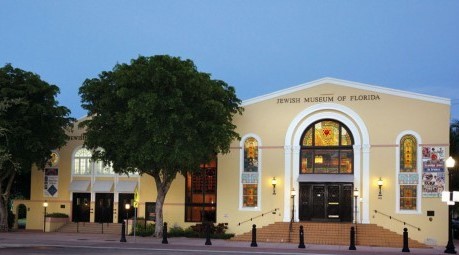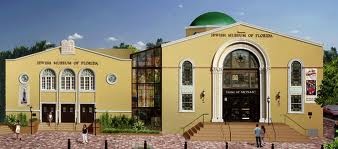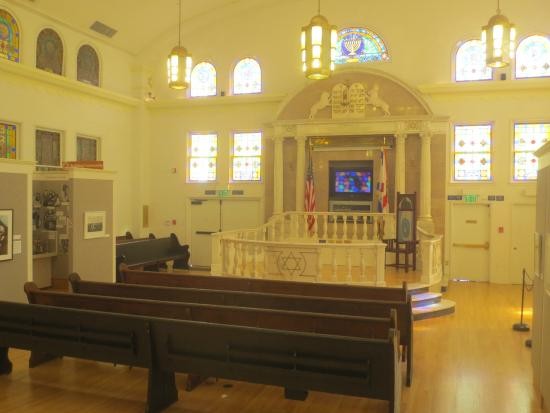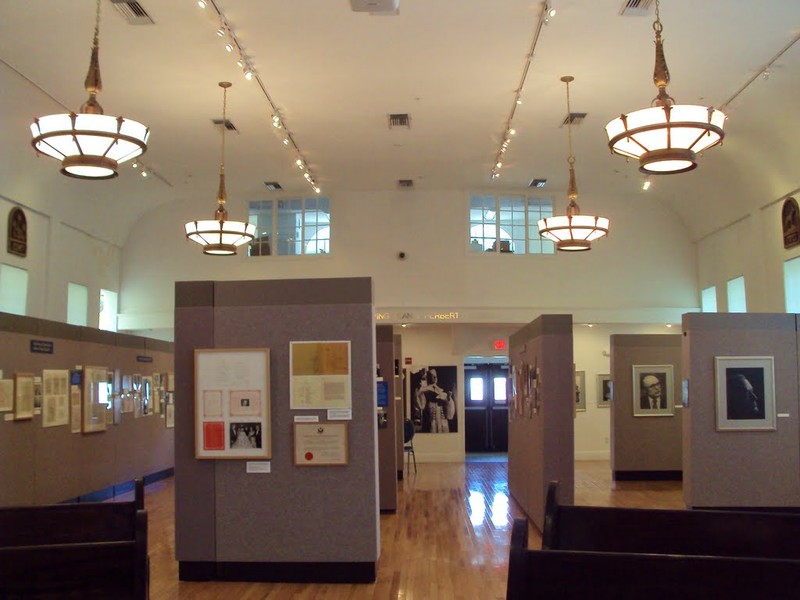Jewish Museum of Florida - FIU
Introduction
Text-to-speech Audio
Images
Left: the 311 building built in 1929. Right: the newer 301 building built in 1936.

The Jewish Museum of Florida is housed in the first two significant buildings constructed for the Jewish community in Miami Beach. An artist's rendering shows the unimpeded facades of both buildings.

Synagogue Within JMOF - FIU.

Interior of the Museum.

Backstory and Context
Text-to-speech Audio
In 1929, the original Beth Jacob Congregation building was constructed in response to a growing Jewish community in Miami Beach. Though the congregation was formed just two years before, almost every permanent Jewish resident of Miami Beach was a member. The synagogue was the first to be built in Miami Beach; members of the Jewish community previously had to ferry across Biscayne Bay to the B’nai Zion Congregation in Miami. Architect H. Frasser Rose designed the building, which was built at 311 Washington Avenue for a total cost of $25,000. The Beth Jacob Congregation building has a simple two-story rectangular plan and a gable roof. The building displays considerable Spanish influence through the use of stucco, stylized iron hinges, and round windows. Three sets of double doors lie at the base of the façade. A plaque at the top of the façade reads, “Beth Jacob Social Hall, 5689-1929,” and is capped by a tablet carved with the Ten Commandments. As the Beth Jacob Congregation was Orthodox, attendees were segregated by gender. Men were allowed to worship on the main floor, while women were relegated to a second-floor balcony.
As the Beth Jacob Congregation continued to expand in the early 1930s, more space was needed. A larger second facility was constructed next to the original building in 1936. Located at 301 Washington Avenue, the new building was designed by congregation member Henry Hohauser. The Synagogue was likely Hohauser’s first completed building design. Hohauser would later go on to design more than one hundred Streamline-Moderne commercial and residential structures in Miami Beach. The 301 building resembles the 311 building in both form and function. Though the 301 building is slightly larger, it maintains the ratios and proportions of the 311 structure. Instead of three sets of double doors, the 301 location has a single set of double doors underneath a large arched stained-glass window. Both the interior and the exterior of the building display a wide variety of Art Deco touches, most striking of these which are the seventy-seven stained glass windows installed in 1940. They were designed by a Beth Jacob rabbi, Moses Mescheloff, and created in Hialeah, Florida.
After the completion of the 301 building, the 311 building became a social and community center. Religious school classes were also taught there. In 1980, both buildings were placed on the National Register of Historic Places due to their significance to Jewish history in South Florida. However, as the twentieth century wore on, Beth Jacob Congregation found itself with a rapidly dwindling community. Many members moved to more affluent parts of town, as the area around Washington Avenue was becoming a high crime neighborhood, or passed away due to age. The Synagogue often struggled to even assemble a minyan – the minimum ten men necessary for many aspects of worship. The historic buildings were ravaged by vandals and hurricanes. By the 1990s, it seemed like the end of the road for the buildings, which were set to be demolished and replaced with an apartment complex.
In 1993, the Beth Jacob Congregation’s buildings were saved by MOSAIC. MOSAIC was founded by Marcia Jo Zerivitz and served as a grassroots Jewish history organization dedicated to preserving the stories of Floridian Jews. The organization travelled all over Florida in the early 1990s collecting photographs, objects, and oral histories. Public reception of MOSAIC was overwhelmingly positive, which allowed it to purchase the two synagogues. MOSAIC then evolved into the Jewish Museum of Florida (JMF). The Museum officially opened at the Beth Jacob Congregation buildings in 1995. JMF contracted architect Ira D. Giller to restore the dilapidated 301 building to its former glory. Giller accomplished this by replacing electrical and plumbing systems, installing a new wooden floor, and shoring up the foundation to ensure safety from environmental hazards. Next, the exterior of the building was steamed. This process removed twenty-seven coats of paint, which were replaced with a new layer to replicate the original color of the buildings. All seventy-seven stained glass windows were repaired and insulated with hurricane-proof glass to protect from further damage. The restoration cost just under $2 million. Two years later, JMF was honored by the National Trust for Historic Preservation for their efforts.
JMF was accredited in 2002 by the American Association of Museums, thanks to the Museum’s dedication toward multi-cultural education and demonstrations via exhibitions, public programs, and archival materials and its passionate way of contextualizing the challenges of the immigrant experience. In 2005, Giller was again contracted for restoration work, this time on the 311 building. The project cost just under $1 million. The 301 and 311 buildings were bridged in 2008 by the addition of the Bess Myerson Gallery. This space lies between the historic buildings, bringing the total floorspace of JMF to nearly 15,000 square feet. In 2012, JMF partnered with Florida International University to become the Jewish Museum of Florida – FIU (JMOF - FIU). This partnership allows for a variety of interdisciplinary and scholarly opportunities. JMOF - FIU is centered around the permanent Mosaic Core Exhibit, which explores the lives of three centuries of Florida Jews. In addition to this exhibit, the museum also features a variety of temporary history and art exhibits. Some of the other permanent exhibits at the museum include a Timeline Wall of Jewish History, a film depicting the Jewish history of Florida, and JMOF - FIU’s massive Collections and Research Center that continually grows and is used by scholars, historians, journalists, and families.
Sources
About, Jewish Museum of Florida - FIU. Accessed November 12th 2020. https://jmof.fiu.edu/about/.
Exhibits, Jewish Museum of Florida - FIU. Accessed November 12th 2020. https://jmof.fiu.edu/exhibits/.
Henry Hohauser (1895-1963), Miami Art Gecko. Accessed November 12th 2020. https://miamiartgecko.wordpress.com/about-the-architect/.
Historic Buildings, Jewish Museum of Florida - FIU. Accessed November 12th 2020. https://jmof.fiu.edu/about/historic-buildings/.
Kirby, Elizabeth A. Beth Jacob Social Hall and Congregation, National Register of Historic Places. July 28th 1980. Accessed November 12th 2020. https://npgallery.nps.gov/GetAsset/3a615a78-215e-4b01-b618-fb4c5c3fd3e7.
Art Geek. Accessed November 10, 2020. https://www.artgeek.io/museums/5c66e808e52986fa2f45d3a3.
